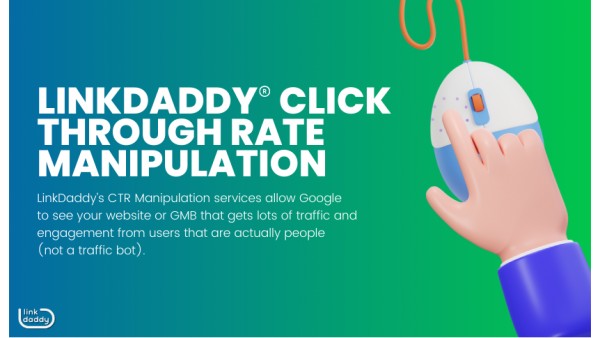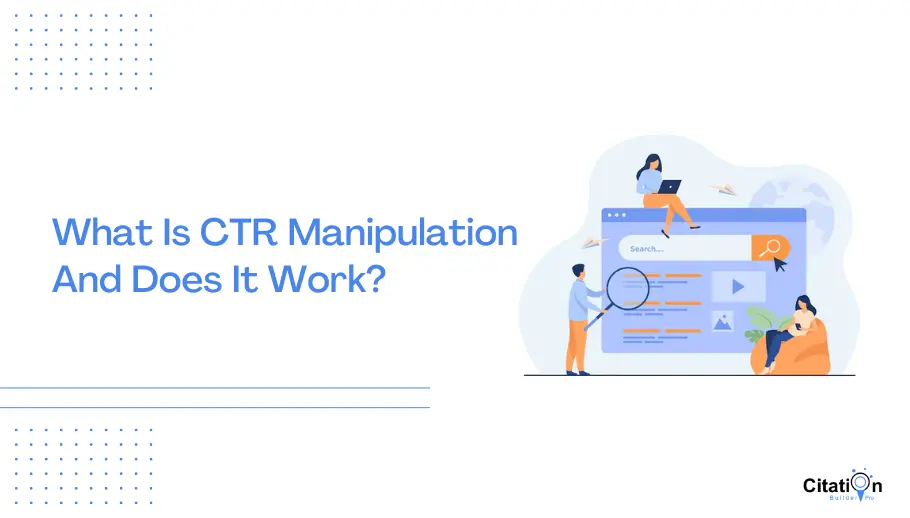Discover the Power of CTR Manipulation Press Release for Maximum Direct Exposure
Wiki Article
Enhancing Organic Click-Through Rates With CTR Adjustment
The optimization of natural click-through rates (CTR) is a nuanced undertaking that hinges on comprehending both user psychology and efficient web content presentation. By leveraging strategic manipulation methods, such as strongly crafted headings and aesthetically appealing elements, online marketers can significantly improve customer engagement. Nevertheless, the landscape is swarming with misconceptions and oversimplifications concerning what really drives CTR. As we check out the details of these strategies, it becomes important to determine the underlying concepts that can lead to sustained success in capturing audience attention. What absolutely distinguishes the efficient from the inadequate in this important aspect of electronic advertising?Recognizing Click-Through Fees
Recognizing click-through rates (CTR) is vital for reviewing the efficiency of on-line advertising and marketing strategies. CTR gauges the percentage of customers who click a certain web link or advertisement compared to the overall number of users who see it. A higher CTR suggests that the content is engaging and relevant to the target market, while a lower CTR may signal a requirement for optimization.To compute CTR, split the number of clicks by the variety of impacts and increase by 100. As an example, if an ad gets 300 clicks out of 10,000 impressions, the CTR would certainly be 3%. This statistics is vital for assessing different components of electronic advertising, consisting of search engine optimization (SEO), email projects, and social media sites advertising and marketing.
Moreover, analyzing CTR assists marketing professionals determine which approaches produce the best outcomes and which call for improvement. By concentrating on boosting CTR, businesses can improve their web content's presence and efficacy, bring about raised website traffic and prospective conversions. Comprehending the nuances of CTR is foundational for any kind of online marketer aiming to optimize their online visibility and take full advantage of roi (ROI)

The Psychology of Individual Behavior
User actions is considerably affected by psychological elements that dictate just how individuals interact with online web content. Recognizing these variables is important for optimizing click-through prices (CTR) in natural search outcomes. Cognitive prejudices, such as the anchoring result, play a critical duty in shaping customers' understandings. When users run into info, their preliminary perceptions can greatly influence their succeeding judgments regarding importance and reliability.Emotional actions additionally dramatically influence user behavior. Content that reverberates mentally can set off a sense of urgency or curiosity, motivating users to click. Furthermore, social evidence-- such as customer reviews or rankings-- can improve depend on and urge engagement, as people usually seek to the behaviors of others to educate their very own decisions.
Moreover, the principle of deficiency can drive clicks - CTR Manipulation. Limited-time deals or special material produce a fear of missing out on out (FOMO), engaging individuals to act quickly. Comprehending these mental chauffeurs makes it possible for marketing professionals to create more compelling content that resonates with their target market
Effective CTR Manipulation Techniques
Leveraging psychological insights can dramatically boost click-through rates (CTR) through targeted adjustment strategies. One of the most effective approaches is making use of engaging headlines that stimulate inquisitiveness or seriousness. Phrasing titles as questions or including numbers can draw in even more focus, prompting individuals to click.An additional strategy involves enhancing meta descriptions to develop a feeling of significance and immediacy. By plainly detailing the advantages or visite site remedies provided in the content, you can involve potential visitors and encourage them to click. Furthermore, utilizing power words-- such as "exclusive," "confirmed," or "free"-- can enhance the appeal of your material.
Aesthetic components also play a crucial role. Integrating captivating photos or thumbnails can attract customers in and enhance CTR. A/B testing various visuals can help recognize which photos reverberate ideal with your target market.
Finally, making certain that your material promises deliverable value brings about higher CTR. When customers perceive that clicking will certainly give them with purposeful understandings or remedies, they are more probable to involve. By employing these techniques attentively, online marketers can successfully control CTR to their benefit while keeping honest standards.
Usual Misconceptions Concerning CTR
Several mistaken beliefs surround click-through prices (CTR) that can lead marketers to make misguided choices. While a high CTR suggests that even more customers are clicking, it does not guarantee conversions or sales.Another common belief is that CTR is a separated metric. In truth, CTR must be assessed in combination with other efficiency indications, such as bounce rate and conversion price, to gain an all natural sight of project success.
Furthermore, some marketers assume that enhancing for CTR alone suffices. However, concentrating specifically on CTR can cause clickbait tactics that might bring in clicks but fall short to engage customers meaningfully. This technique can hurt brand name credibility and cause reduced retention prices
Lastly, there is a notion that CTR approaches are universally efficient. The reality is that optimal CTR techniques can differ dramatically throughout industries and target market, demanding tailored strategies for various market sections. Understanding these misconceptions is essential for establishing reliable CTR strategies that straighten with overarching advertising and marketing objectives.
Determining CTR Success
Although high click-through rates (CTR) can indicate successful engagement with web content, determining their true success calls for a detailed evaluation of several aspects. First, it is important to understand the context in which the CTR is achieved. A high CTR on a deceptive title may not equate to purposeful interaction or conversions, inevitably reflecting poorly on the brand's reliability.2nd, examining the source of web traffic is important. Organic website traffic from internet search engine can represent a robust material technique, while clicks from irrelevant sources might suggest an absence of targeting. Furthermore, gauging the succeeding individual habits is crucial; evaluating metrics such as bounce price, time invested on web page, and conversion prices can give deeper insights into the top quality of the engagement initiated by the CTR.

Final Thought

The optimization of organic official source click-through prices (CTR) is a nuanced venture that pivots on recognizing both user psychology and reliable material presentation. CTR determines the percent of customers that click on a certain web link or advertisement contrasted to the overall number of individuals that see it. A higher CTR shows that the material is involving and appropriate to the target audience, while a lower CTR may signify a demand for optimization.
Concentrating exclusively on CTR can lead to clickbait methods that might draw in clicks however stop working to involve users meaningfully. In addition, measuring the subsequent customer habits is important; evaluating metrics such as bounce rate, time spent on web page, and conversion prices can give much deeper understandings into the high quality of the involvement initiated by the CTR.
Report this wiki page